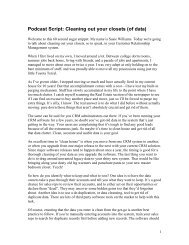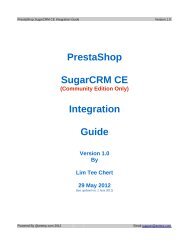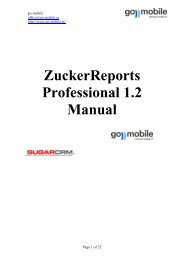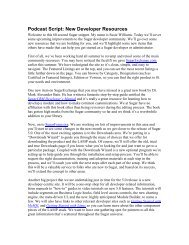Sugar Community Edition Installation and ... - SugarForge
Sugar Community Edition Installation and ... - SugarForge
Sugar Community Edition Installation and ... - SugarForge
Create successful ePaper yourself
Turn your PDF publications into a flip-book with our unique Google optimized e-Paper software.
Chapter 2Administering <strong>Sugar</strong>Creating RelationshipsTypically, a <strong>Sugar</strong> module has relationships with other <strong>Sugar</strong> modules. For example,Accounts is related to Contacts, Leads, Opportunities, <strong>and</strong> several other modules.Related records from these modules display in fields or sub-panels on an account’sdetail page. You cannot edit these pre-defined relationships.In Module Builder, you can create relationships between undeployed modules, <strong>and</strong>between undeployed modules <strong>and</strong> deployed modules. However, you cannot createrelationships between deployed modules. If you want to change a relationship afteryou have deployed the module, you can redefine or delete the relationship <strong>and</strong> then redeploythe module package.In Studio, you can create relationships only between deployed modules. After youdeploy a relationship in Studio, you cannot change it.You can create one relationship at a time. When you create a relationship for amodule, it is considered to be the primary module <strong>and</strong> the module that you relate itwith is the related module. Depending on the relationship type, the relationship isexpressed with sub-panels <strong>and</strong> Related-to fields. When you create a new relationshipbetween two modules, the system automatically creates the necessary sub-panels,related-to fields, <strong>and</strong> metadata relationships.You can also create a relationship between a module <strong>and</strong> itself. In this case, therelationship becomes a parent-child relationship. For example, you can create arelationship from Accounts to Accounts in order to create sub-accounts within theprimary account.In Module Builder, you can select Activities as the related module but not its submodulessuch as Tasks, Calls, <strong>and</strong> Meetings. The relationship is automaticallyreflected in these sub-modules.In Studio, you can select a sub-module of Activities when you create a relationship.So, when you select Activities as a related module in the Module Builder, you can useStudio to further define the relationship for its sub-modules.Relationship Types. The three relationship types are as follows:One-to-one: In this relationship, records in the primary module <strong>and</strong> the relatedmodule are uniquely related to each other. For example, an account can beassociated with only one contact <strong>and</strong> a contact can be associated with only oneaccount. This account value will display in the contact’s detail page <strong>and</strong> thecontact value will display on the account’s detail page.One-to-many: In this relationship, records in the primary module can haverelationships with many records in the related module. For example, an accountcan be associated with many contacts, <strong>and</strong> many contacts can be associated withthe same account. The Detail View of Accounts will display a Contacts sub-panel,<strong>and</strong> the Detail View of Contacts will display a Related-to field containing a link tothe related account.Many-to-many: In this relationship, records in both the primary module <strong>and</strong> therelated module can have relationships with multiple records in each module. Forexample, an account can be associated with many bugs, <strong>and</strong> a bug can be88 <strong>Sugar</strong> <strong>Community</strong> <strong>Edition</strong> <strong>Installation</strong> <strong>and</strong> Administration Guide
















